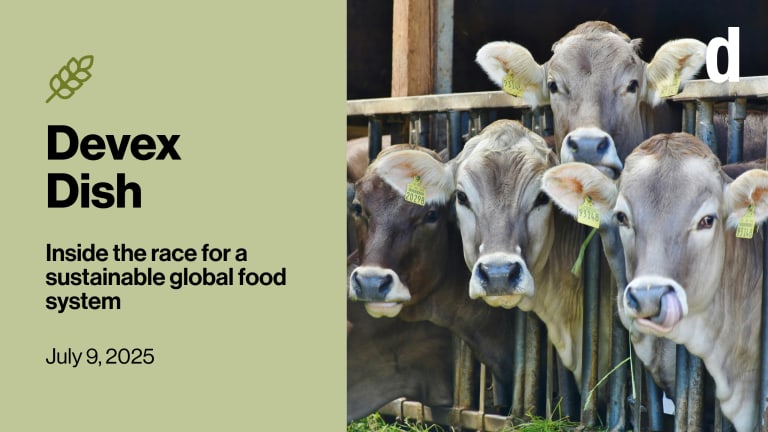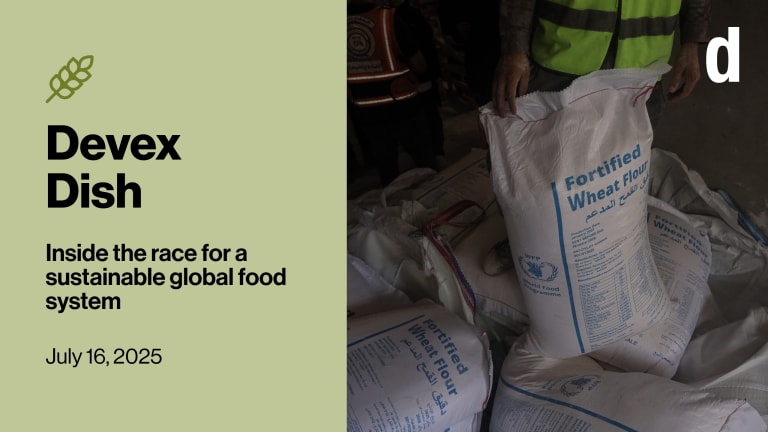
The global food systems transition is not happening fast enough.
You’ve probably heard of the energy transition needed to achieve the Paris Agreement’s goal of keeping the global temperature rise well below 2 degrees Celsius from pre-industrial levels. Even better if we can limit it to 1.5 C.
But the greenhouse gas emissions from the global food system alone make it impossible to prevent a 1.5 C rise, according to an alarming new report from the Animal Law & Policy Program at Harvard Law School. That means that food systems, which account for roughly one-third of all global greenhouse gases, need to go through their own transitions. That’s especially true of livestock production, which accounts for more than half of those emissions.
This is a preview of Devex Dish
Sign up to this newsletter to get the inside track on how agriculture, nutrition, sustainability, and more are intersecting to remake the global food system in this weekly newsletter.
For the first time, the report lays out a timeline for what needs to happen to effect that food transition and get the sector in line with the Paris Agreement. Most of the 210 climate and sustainable agriculture experts consulted agree that the timeline is a short one — with wealthier nations needing to change habits much faster. To wit:
• Most of the experts — nearly 80% — believe that the total number of global livestock needs to peak next year.
• 35% of experts agree that livestock emissions in high- and middle-income countries should also peak by next year, and 30% believe they must peak after 2030 in low-income countries.
• There is also a consensus that people need to shift their diets from animal-based foods to meat alternatives. In high-income countries there needs to be a fairly dramatic shift, while middle- and low-income countries must also make some change.
The problem is that there’s little consensus on how to make these changes happen and also balance them against critical nutritional needs, particularly in low-income settings.
A discussion organized earlier this month by Jessica Fanzo, a professor at Columbia University’s Climate School, hit on some technical solutions, like methane vaccines, that would be particularly helpful in reducing emissions in high-income settings. And lower-income settings would benefit from better conditions for existing livestock, boosting overall production, and limiting the need to increase stocks.
But the more important work of broadly shifting people toward more plant-based diets, particularly in wealthier countries, remains an ongoing challenge. Unfortunately, as the report makes clear, we don’t have a lot of time to find an answer.
Read: No easy answers in shift away from animal-based foods
Background reading: The debate over meat at COP 28, explained
False flag?
Don’t be surprised if you find the meat industry pushing back against some of those findings with the backing of research from some heavy-hitting academic institutions. Another recent report published in the Climatic Change journal has found that the animal agriculture industry is funding researchers to the tune of millions of dollars to “obstruct unfavorable policies as well as influence climate change policy and discourse.”
The strategy probably sounds familiar because other industries — including manufacturers of sugary drinks and the oil and gas sector — have run a similar playbook.
In this case, the animal agricultural industry is using the research it funds to argue that there is no need to reduce the consumption of meat or dairy as they don’t contribute to climate change. That, of course, is the exact opposite of what research not funded by the industry has found.
On the brink
Northern Gaza could descend into famine any day now, as people across the territory face “catastrophic levels of hunger,” according to a report Monday from the world’s authority on food security.
As Israeli forces continue to restrict humanitarian aid to the region, as many as 1.1 million people — half of Gaza’s population — face the most severe level of food insecurity, according to the new report from the Integrated Food Security Phase Classification. And the territory’s entire population is suffering from high levels of acute food insecurity.
More than 12% of children under 5 years old in Gaza’s northern governorates are already acutely malnourished, according to the report, and most households are skipping meals. If Israel continues to block access to fresh water and food, the results could be catastrophic, fueling a rise in starvation and disease that could threaten the “well-being of an entire future generation,” the World Health Organization warns.
Related: Why famine is ‘inevitable’ in Gaza – and what’s next
+ The war in Gaza and its humanitarian crisis are some of the global issues that could be impacted by this year’s U.S. presidential election. Join us on April 3 to discuss how a second Trump or Biden administration could shape the U.S. role in global aid and development. Save your spot now.
The secret sauce
The Asian Development Bank saw a massive jump in climate finance numbers in 2023, with $9.8 billion committed, up from $6.7 billion in 2022. Warren Evans, ADB’s special senior adviser on climate change, tells my colleague Vince Chadwick this comes in part because of an evolution in focus, including how the bank thinks about supporting agricultural systems.
From an emphasis on climate proofing, the lender is now looking at how to make projects resilient to climate risks. Evans gave the example of looking at how an irrigation project can not only boost agriculture, but also helps the farmers build resilience to climate change. ADB sees that as a win-win: an improvement to the agricultural sector that should help mitigate against the impacts of climate change.
Read: The strategy behind ADB’s massive climate finance numbers (Pro)
+ A Devex Pro membership gives you access to all of our expert analyses, insider insights, career resources, exclusive events, and more. If you aren’t a Pro member yet, start your 15-day free trial today.
Tune in
Bringing home the bacon
Your next job?
Food Security and Livelihoods Sector Co-coordinator
Mercy Corps
Syria | Jordan
In a world that is inherently unequal — including in its access to food — will technology such as artificial intelligence be harmful or helpful? “Technology tends to be a fairly neutral tool. It multiplies whatever is underneath it. So if we have a completely inequitable system, it will multiply the inequity,” Roy Steiner, senior vice president for the food initiative at The Rockefeller Foundation, tells Devex in a special episode of our weekly podcast, This Week in Global Development.
He spoke to us on the sidelines of the South by Southwest conference last week in Austin, Texas. Also featured in this episode are Paul Newnham, executive director of the SDG2 Advocacy Hub, and Joke Aerts, open chain lead at Tony’s Chocolonely.
Listen: Technology's role in the future of food systems
+ Keep up with our coverage of SXSW 2024.
Chew on this
Polish farmers blocked two borders with Germany this week in protest against farm imports from outside the European Union and the bloc’s environmental regulations. [Deutsche Welle]
An undercover investigation reveals how ordinary sand has been disguised as subsidized fertilizer and sold to farmers across Kenya. [Africa Uncensored]
Ahead of World Water Day on Friday, Action Against Hunger released a report that found only 36% of requests for water-related funding programs were filled in 2023. [Action Against Hunger]








